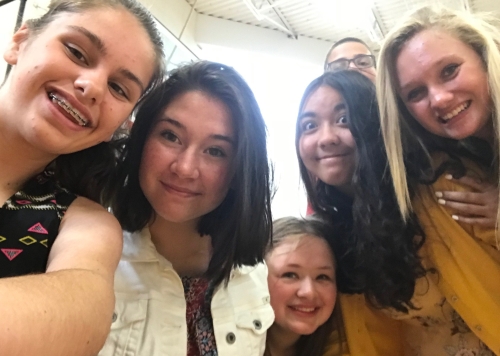
I remember the day The Awkwardness hit. I was 13 and had just arrived at the pool in my aunt’s neighborhood. It was blue and sparkling and I couldn’t wait to get in it. But as I walked to the edge of the pool in my modest 2-piece swimsuit, I was struck by self-consciousness. I felt exposed and judged.
Jumping in to hide my embarrassment, I stood in the water feeling confused. I couldn’t remember what was fun about swimming. Not a strong swimmer, I took a few practice strokes and then stopped again, bouncing in water about neck deep. I looked at the other kids: some were doing cannonballs, but that would involve climbing out of the protection of the water; some were splashing each other, but that was irritating; others were screaming and laughing for no apparent reason. I did a couple of underwater handstands just to prove to myself that I still could, and then I climbed out, hiding my exposed skin under a beach towel as I stretched out on a lounge and tried to understand what I’d lost.
Most adults remember junior high as a difficult, sometimes painful stage. Middle school and early adolescence are well known for causing insecurity and self-consciousness. When you think about all the changes going on during this time of life, it’s clear that are many reasons to feel out of sync.
Physical Awkwardness. Because limbs are growing so fast, it’s normal to be clumsy. Parents and teens are both relieved to hear that it’s temporary, but I do suggest moving some valuables off of end tables to protect them from off-balance stumbling. Body shapes are changing, which is why 13-year-old girls stand with arms folded, while the boys leap to see if they can slap the top of the doorway yet. Acne, greasy hair, braces, and body odor make their appearances during middle school, leading to being obsessed with one’s reflections (and incessant selfies).
Some kids want to dress like their older peers while others don’t want to give up their childhood icons. It’s a good time for discussions about the impressions we give by what we wear, and the importance of learning what’s appropriate in various social situations. It’s also a good time to discuss modesty, grooming, and how to do laundry.
Social Awkwardness – Middle schoolers are known for mumbling, laughing loudly, being inconsiderate, using bad language, having no manners, and being lazy. Much of this stems from being smack in the middle between childhood and adulthood. They want to have a foot in each world, and the adults in their lives will expect them to be children one day but young adults the next. If I hand out treats in class, I have to remind the first 5 or so to say thanks. The rest will eventually catch on. I daily remind them to to clean up after themselves, and to step to the side of the hallway because they’re blocking traffic.
Keep in mind that much of what we call “common sense” is actually a collection of life skills and courtesies gained from experience. Someone taught you to modulate your voice in consideration of others; it’s your turn to teach the teens in your life. I like to use one-word prompts rather than questions or demands. I’ll say “Manners!” instead of “What do you say?” or “Volume!” instead of “Lower your voice!”
In social situations, there are also skills that need to be taught, such as shaking hands, looking people in the eye, and making conversation. Teens will answer with “Fine” or “I guess” unless they’re taught how to converse and given a chance to practice. Explain that when an adult says, “How’s school?” a better answer is “I love math, but I hate gym.” Teens are relieved to hear that often adults will then take over the conversation with their own stories, but they also have to be taught to respond with “Wow” or something to indicate they’re listening.
Emotional Awkwardness. I remember being 11 and crying in the backseat because we were in my grandma’s neighborhood but couldn’t stop to visit her. My parents were as surprised by I was by my tears. Hormones and growth spurts contribute to the emotional roller coaster that is adolescence, and teens are often surprised and embarrassed by the strength of their feelings. Being out of peanut butter can bring on a raging tantrum, while a misused word by a friend can cause uncontrollable laughter. I sometimes send students out of the room to get themselves under control. Usually it just takes a walk down the hall to the restroom for them to calm down.
There are red flags to watch for at this age, such as violent rages or depression that lasts for more than a few days. Thanks to social media, this is also when self-harm (cutting) or experimenting with chemicals becomes a real temptation. It’s not just drugs and alcohol; there are YouTube videos encouraging teens to try various items from the medicine cabinet or kitchen cabinet to “make you feel funny,” which young teens don’t equate with “getting high.” Familiarize yourself with the possible signs of substance abuse: glassy stares, ongoing changes in sleep or eating habits, new friends that make you feel uncomfortable, a sudden drop in grades (learn more here). Try to keep tabs on what they’re doing on their phones. Parents who want to protect their teens’ social privacy can miss early warnings.
I know adults who say they never outgrew their awkward years, but the reality is most of us learn to fit in with the grown-ups through observation and practice. Last week I went to the pool and got into the water without feeling (too) self-conscious. However, I only swam a few strokes before getting back out because the kids near me were splashing.
Some things don’t change.
